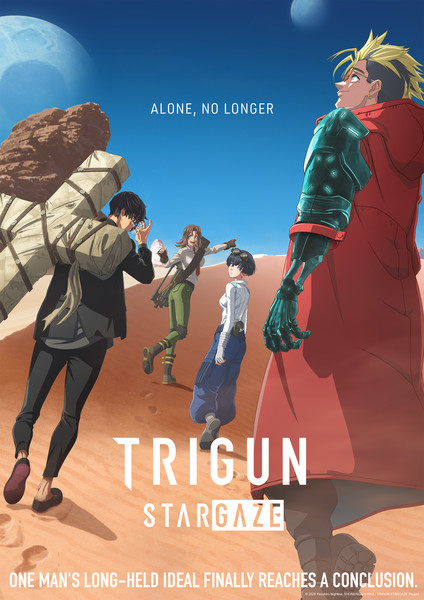Trigun Stargaze Aims for the Stars: Episode 1-2 Review
by Caroline Cao,
“Love and Peace,” hollered scores of Vash cosplayers at the Trigun Stargaze panel at New York Comic Con, hosted by Crunchyroll. That's a lofty dream for the much-beloved pacifist gunslinger, Vash the Stampede, in the desert Noman's Land. At the panel, the Trigun mangaka Yasuhiro Nightow, whose manga started in 1995 before a hiatus, then returned with Trigun Maximum (1997 to 2007), said, “As people started discovering Trigun through Stampede, I felt the love toward Vash… both loving each Vash individually, I felt the love for everything... I love how we could love the same but different Vashes.”
This reimagining extends to other Stampede and Stargaze cast members, as fans found out during the two-episode exclusive premiere of Stargaze.
The Humanoid Typhoon has carried over a titanic weight on his shoulders from the last finale of Trigun Stampede. Not only did Vash (Yoshitsugu Matsuoka) have to watch the disintegration of his brother, Million Knives (Junya Ikeda)–in the midst of raving about annihilating the humans to create a utopia for powerful Plants like them–the megalopolis of JuLai has been decimated into a titanic crater due to Vash and Knives's climactic fight.
Before I get into the two-episode premiere of Trigun Stargaze, the final chapter after Stampede (directed by Masako Sato with Takehiko Oxi credited for original story), it should come with an admittance that I have not acclimated wholly to the Orange Studios 3D renderings of human—or humanoid in Vash and Knives' case—bodies that move in Noman's Land of Trigun Stampede (designs that fared more eloquently in the anthropomorphic creatures in BEASTARS). Despite a bevy of beautiful backdrops, like the cratered moon staring down on the desert as a sobering reminder of an aftermath, I rarely felt that the characters (Kōji Tajima as concept artist and original character design and Kiyotaka Oshiyama as animation character designer), the fabrics that clothed them, and slapsticky gags are dispatched as idiosyncratically and industrially as in the original 1998 Madhouse anime, despite its envelope-pushing range of faciality and combat physicality. But otherwise, Studio Orange exercises plenty of competence in dressing the ramshackle western and cosmic atmospheres, even when I felt Orange's human faces felt too paled compared to the Madhouse design. Despite my favoritism for Madhouse, the Studio Orange reboot of Trigun has been engaging despite my hang-ups.
Episode one of Stargaze reinforces the haunting question. As a grown-up Meryl Stryfe (Sakura Andō), a young journalist, wonders aloud, "How will Plants and humans coexist, especially when Plants have been a site of exploitation?" “There's no exit to his maze,” one character grouses. Meryl at least has good company. She's now in a professional partnership with a happy-go-lucky gunslinger, Milly Thompson (Chika Ayamori), a long-awaited fan favorite foil to Meryl's serious demeanor. Stargaze grants Milly a strong epic intro (of course, she'll go berserk over a banana split!) with caveats that subtract from what made her earlier iteration mesmerizing in the first place: she's (so far) without the signature overcoat that could comedically store her cylindrical concussion gun as in the original Madhouse anime. This wardrobe highlighted her distinctive physicality from Meryl.
The first episode's premiere ends up being a set-up appetizer for the rib-eye steak of its second episode, which knocks it out of the park with a classical-esque tragedy that feels satisfying standalone while propelling the overall plot. So then, episode two tackles an insurmountable question: How to awaken Vash to his sense of purpose?
This would segue into another question: Why did a Stampede character appear to be replaced with another for Stargaze? It will elicit confusion, as it comes across as a lapse in continuity, unless it's clarified later. Yet, I find that question melts away in favor of the psychological intrigues at the heart of episode two.
I can give away what's already known. As seen last season, in an unknown location, Vash has survived the Fall of JuLai, but he's left an amnesiac, now called Eriks, catatonically plinking one key at a piano in mourning for his twin brother and the mortals he failed to save at JuLai. The renderings put effort into Vash's physical deterioration into an automaton who cannot go through the motions of caring for himself.
The episode focuses intimately on the consequences of the Fall of JuLai by orienting the point of view through Vash's unexpected caretaker, a character who appears in the manga and the anime. At first, especially if you're coming into Stampede and Stargaze without experiencing prior Trigun material, it's easy to assume kindness in the caretaker, but then his reasons become recontextualized or twisted every five minutes we sit with the caretaker's actions and reactions, as we read quiet frictions in gazes, observations, and his growls. He is nursing a fury that he's restraining.
If there is one caveat I have with the second episode, it is that a disabled character serves as a motive object, with little effort to flesh out interiority within the 22-minute runtime. The result is that she's more of a doll than a human being. For a series that reimagines familiar characters, I wondered why she remained stagnant as a symbol.
Still, the emotional devastation hits like a ton of space debris. Memorable in this episode is the twisted morality in the caretaking relationship with Vash, who goes from an object to a renewed purpose. How much of his caretaker's motive is grudge or even a complicated kindness, or an overlap of both? His final closing words in the episode insinuate its multitudes, as if kindness and cruelty can go hand in hand. It strangely fits within the “love and peace” that Vash is searching for.
discuss this in the forum |